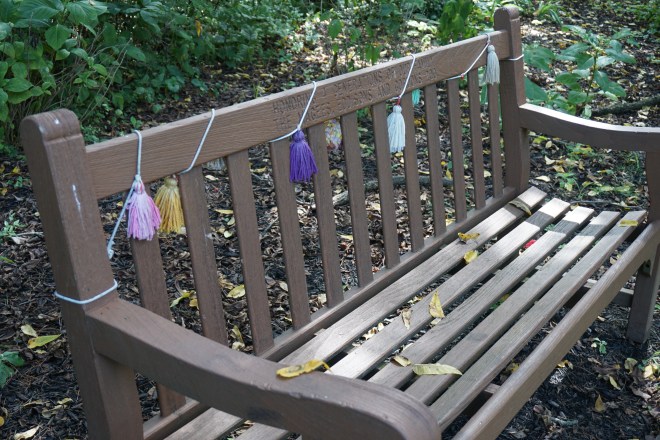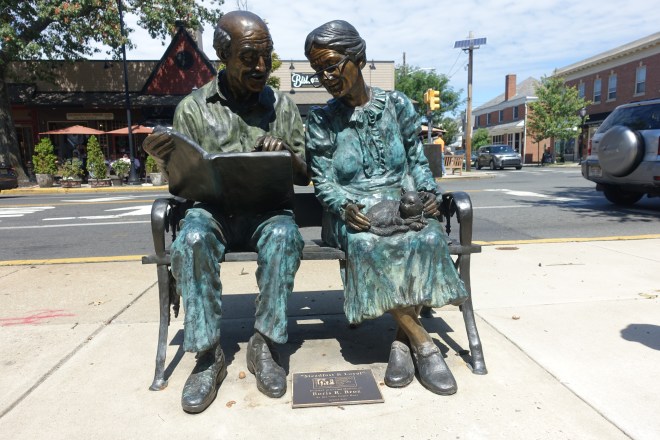My grandson and I decided to visit historic, colonial Haddonfield, New Jersey on Saturday, August 24th.

The town, located in Camden County, was founded in 1682 when Francis Collins established a plantation named Mountwell. In 1701 Elizabeth Haddon, a Quaker woman, came to occupy land that her father purchased and in 1702 she married John Estaugh, a Quaker minister. A Quaker meeting house was erected around 1721 and the town began to grow.

The Quaker Society established a cemetery where history is interred. It’s very quiet and restful and serves as a place where children sled in the depths of a winter snow.

Haddonfield is one of the lovely towns in South Jersey and is very photogenic. It’s home to a sculptural community with numerous installations. I gave my grandson one of my cameras and we set off to photograph the various pieces of art and snippets of the town. What follows is the joint effort of both of us. We hope you enjoy our work.
As you enter the town you are greeted by the bronze statue “Ballerina,” on the circle at Haddon Avenue and Ellis Street.

As we strolled around we came upon “My Blue Dog,” which was created by well known Haddonfield sculptor John Giannotti, sitting at the corner of Haddon Avenue and Kings Highway.

And here’s a shot of My Blue Dog and our faithful companion.

From there we moved sought out the “Children’s Sculpture Zoo” in search of a bronze seal, frog and rabbit. As we walked along the Kings Highway we came upon this little pup, protected from the sun, which we found colorful and entertaining . . .

. . . and these flowers.


We passed the municipal building as we made our way.

Here are a few shots in the sculpture zoo.




Here’s an another one of the hare which is pretty intimidating.

And, last but not least, the seal.


And, one of my grandson.

This little sculpture garden is a quiet oasis in the middle of a small colonial town; a place to sit and contemplate nature and your environment. Here is one of the benches where one can sit.

The local architecture and gardens greeted us as we strolled along. There is nothing cooker cutter about the homes in this quaint community.


Outside the local post office stands this statue of “The Postman”; “neither rain nor snow nor . . .”, oh well you know the poem.

Then, we found this sculpture of a young woman riding on the back of a bull entitled “Europa.” Sorry about the lighting.


We met “Stanley the Witness,” an aluminum sculpture painted to resemble weathered bronze, on Kings Highway.

As we walked along we came upon this little sitting area, outside a home on Kings Highway. I liked the composition and snapped this shot. You can find an egret, or is it a stork, almost anywhere.

Then we located what turned out to be my favorite work of art, entitled “Uno.” It’s bronze and steel and is a permanent installation located at Mechanic Street and Haddon Avenue. It’s absolutely beautiful. What follows is my “study” of this wonderful piece.





And one of my grandson as he studied Uno and took a photo.

This piece is called “Steadfast and Loyal” and intrigues people walking on the Highway. I wonder what they are reading? Maybe they are planning their next trip.


This low-poly welded, laser-cut aluminum work, entitled “The Heart of Haddonfield,” stands at the entrance to Kings Court and is located in the center of town. It’s a popular gathering point for and stands at the entrance to the farmer’s market which pops up every Saturday in summer.



Here is another view of King’s Court after the farmer’s market is taken down.

Looking southerly on Kings Highway one sees the town clock.

A photo of some of the shops lining Kings Highway.

At Markeim Art Center, corner of Lincoln and Walnut Streets, one can find “Muse,” a stainless steel work by Joe Mooney.

Then we stumbled upon “Refugee,” a work by Joe Brenman at the corner of Kings Highway and South Haddon Avenue. How apropriate for our time.


On Mechanic Street are a number of tiles embedded in the wall that lines the street.

And a peek into a backyard is a must.

And now, a bit of history, in 1858 William Parker Foulke, a naturalist and noted Quaker from Philadelphia, while spending some time in Haddonfield was invited to dinner at Birdwood, the home of William Estaugh Hopkins, a descendant of Elizabeth Haddon Estaugh. At Birdwood Foulke observed a large fossil bone being used as an umbrella stand. Finding out that it was just one of several bones found in an old marl pit on the Birdwood Farm property many years earlier, Foulke and his mentor, Dr. Joseph Leidy, obtained permission to re-open the marl pit to look for more bones. The result was the discovery of the first nearly intact dinosaur ever found anywhere in the world. It was named Hadrosaurus foulkii and it changed forever the scientific understanding of dinosaurs.
This is a sculpture of what sculptor John Giannotti imagines Hadrosaurus Foulkii must have looked like. It is installed in the center of town on Kings Highway at Lantern Lane. The dinosaur itself can be found in the Philadelphia Museum of Natural History.

Good bye Haddonfield; we had a great afternoon in your wonderful community.




Hi. First what a special day and way to spendwith your grandson-how lucky you both are! I so enjoyed my trip to a great little town. When I’m away or just going to interesting places I like doing visits like the one to Haddonfield. In this case your descriptions made me feel I was there experiencing so many things that I know a lot of people would never even “see”. Just moving thru life too fast to notice and enjoy! Thanks hi to Joanne. Kn
Sent from my iPhone
>
Thanks; Haddonfield is certainly a lovely town and well worth a visit.
Hi Carl
What a great post. I enjoyed the pics and am now inspired to find these treasures!!! What a fun way to spend time with your grandson and share your love of photography too!!
Keep posting!!! Sharon
Thanks Sharon. It was a fun afternoon and there is a lot more to Haddonfield than we think. The sculptures are diverse and great works of art.